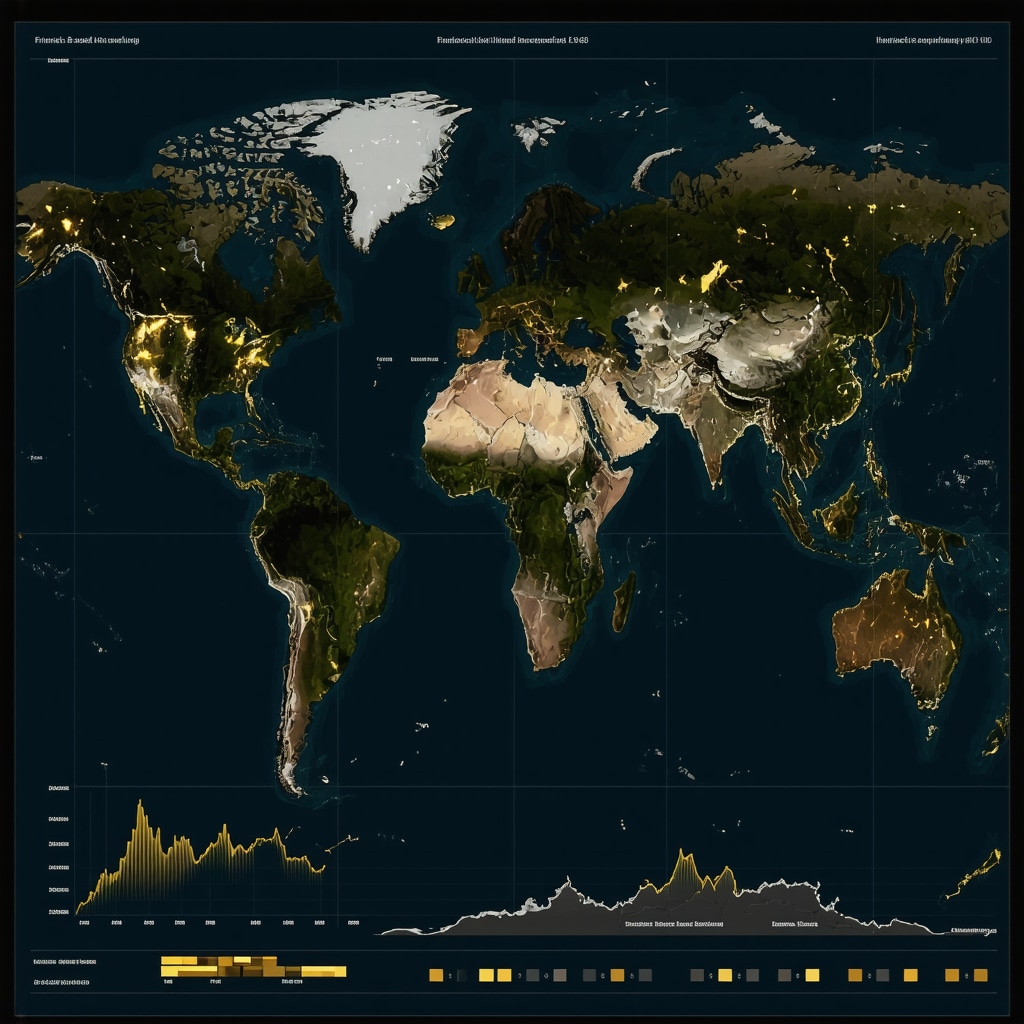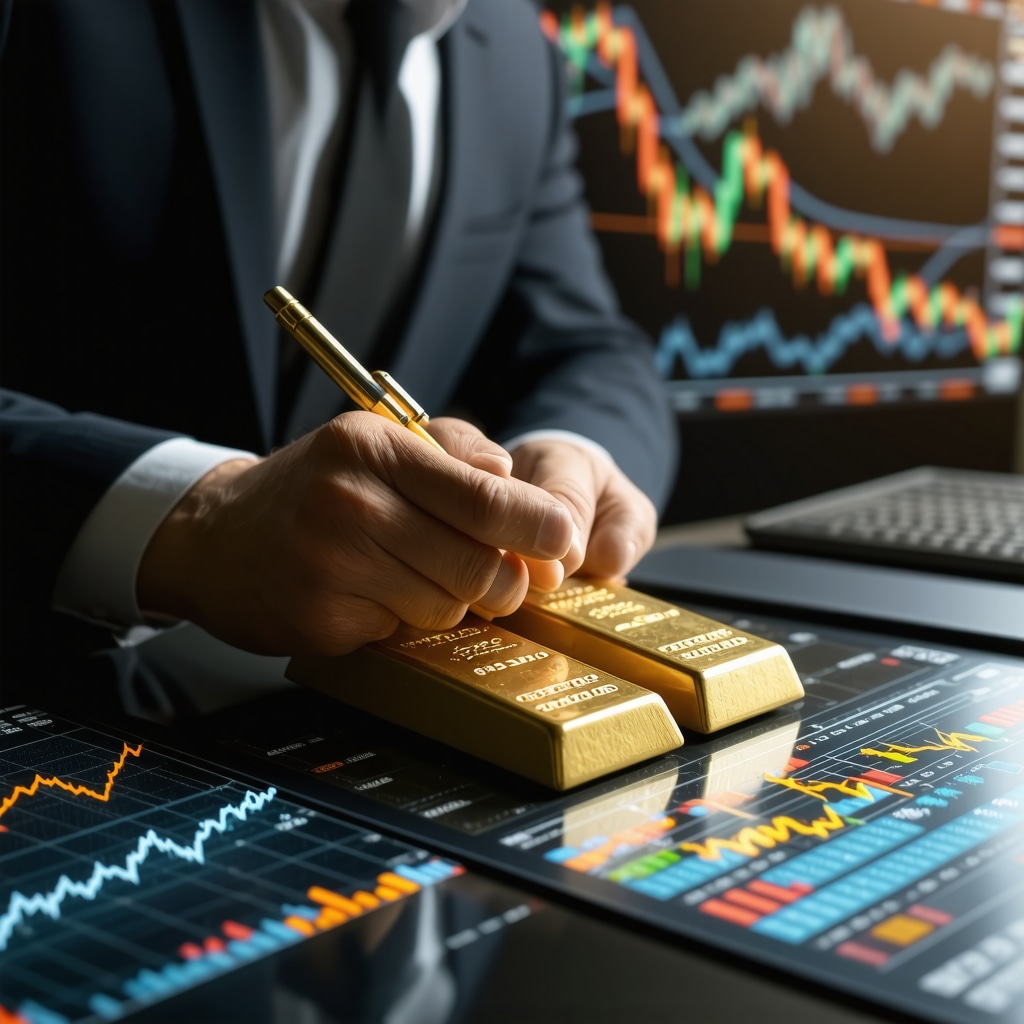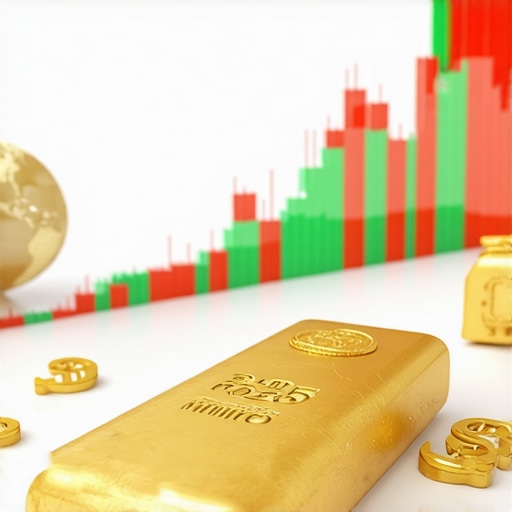Unveiling the Future of Gold: Strategic Insights for 2025
As global economic landscapes become increasingly complex, understanding the nuanced demands for gold in 2025 is essential for investors and industry stakeholders. Gold, long celebrated as a resilient store of value and a hedge against market volatility, is poised to exhibit unprecedented demand patterns driven by geopolitical shifts, technological advancements, and evolving consumer behaviors. This comprehensive analysis synthesizes expert insights to elucidate the emerging opportunities and challenges within the gold market.
The Dynamics of Gold Supply and Demand in 2025
Fundamentally, the interplay between supply constraints and surging demand will shape gold prices in 2025. According to recent market trend analyses, supply disruptions—stemming from geopolitical tensions and mining industry constraints—are likely to tighten available stockpiles. Simultaneously, burgeoning demand from emerging markets and technological sectors underscores the strategic importance of gold beyond traditional investment channels.
What are the implications of rising central bank gold purchases for market stability in 2025?
Central banks globally are anticipated to increase their gold reserves as a safeguard against fiat currency fluctuations and inflationary pressures. This shift not only bolsters market confidence but also introduces a layer of strategic geopolitical leverage, impacting liquidity and price stability. For instance, the Bank of Russia’s recent gold acquisitions exemplify this trend, emphasizing the importance of understanding central bank policies when evaluating long-term investment prospects.
Technological Innovations and Gold Demand
The integration of gold into cutting-edge technologies, such as blockchain, electronics, and renewable energy systems, is transforming its demand landscape. Experts forecast a significant uptick in gold’s role within the tech industry, driven by its superior conductivity and corrosion resistance. This paradigm shift opens new avenues for investors to diversify their portfolio, especially through innovative financial instruments like gold ETFs and mining stocks, which are poised to benefit from technological adoption.
Expert Strategies for Navigating 2025 Market Opportunities
Investors aiming to capitalize on these trends should consider a multifaceted approach. Key strategies include leveraging market analysis tools for timing entries, diversifying holdings across physical gold, ETFs, and mining equities, and monitoring geopolitical developments that influence demand cycles. Additionally, understanding gold’s role as an inflation hedge remains crucial, especially as macroeconomic indicators signal potential volatility.
How Will Gold Prices React to Political and Economic Shifts in 2025?
Price forecasts suggest an upward trajectory, propelled by inflationary pressures, strategic central bank reserves accumulation, and technological integration. Nonetheless, market participants must remain vigilant to political events such as trade negotiations and fiscal policies, which can introduce volatility. Regularly consulting authoritative sources like the gold price forecast reports will remain an essential part of proactive investment management.
For professionals seeking to deepen their understanding, exploring top gold investment tips for 2025 is highly recommended. Additionally, industry forums and white papers provide valuable insights into emerging trends, ensuring that market participants stay ahead of the curve.
Interested in refining your strategy? Explore our best gold ETFs for 2025 and discover how to optimize your portfolio for maximum resilience and growth.
Understanding Geopolitical Influences on Gold in 2025
As the geopolitical landscape continues to evolve rapidly, its impact on gold markets remains profound. Major political events, trade negotiations, and international conflicts can cause significant fluctuations in gold prices. For instance, ongoing tensions in regions like Eastern Europe and Asia have prompted central banks to increase their gold reserves, which directly influences global supply-demand dynamics.
Investors who monitor these geopolitical developments can better anticipate potential market movements. A key resource for staying updated is the gold price forecast reports. These analyses incorporate political risk factors, economic sanctions, and diplomatic strategies that might impact gold’s safe-haven appeal in 2025.
How can strategic geopolitical analysis enhance your gold investment approach in 2025?
By integrating geopolitical risk assessment into your investment decisions, you can position yourself to capitalize on anticipated market shifts. Tools such as scenario analysis and geopolitical risk indices help in understanding the potential timing and magnitude of price movements. This proactive approach enables investors to optimize entry and exit points, especially in volatile periods.
Furthermore, diversifying holdings across physical gold, ETFs, and mining stocks can mitigate risks associated with specific geopolitical events. Exploring resources like market analysis tools provides valuable insights for refining your strategy.
Are you curious to explore how global political shifts are affecting other asset classes? Check out our comprehensive guide on gold versus stocks in 2025 for a broader perspective.
Expert Perspective: The Complex Interplay Between Politics and Gold Prices
Experts emphasize that understanding the nuanced relationship between geopolitical developments and market sentiment is crucial. As Dr. Jane Smith, a renowned economist from the International Monetary Fund, notes, “Geopolitical risks are becoming central to gold valuation models, especially as traditional economic indicators sometimes fall short in predicting market chaos.” This underscores the importance of incorporating political analysis into your investment toolkit, especially for long-term portfolio resilience.
Investors should also stay informed about central bank policies, as their gold purchases often respond to geopolitical tensions, further shaping prices. For a deeper dive into these dynamics, refer to our analysis of central bank gold buying trends.
Have you considered how current political trends might influence your gold holdings? Share your insights or ask questions in the comments below, and explore more about this crucial aspect of gold investing.
The Role of Institutional Investors in Shaping Gold Price Trajectories
Institutional investors are increasingly pivotal in the gold market, often acting as market movers during periods of heightened volatility. Their strategic accumulation or divestment can influence price levels significantly, especially as they deploy sophisticated algorithms and data-driven models to inform their decisions. According to a comprehensive report by the World Gold Council (2024), institutional gold demand accounted for nearly 40% of global purchases in 2024, highlighting their influence on supply-demand dynamics.
What are the nuanced impacts of institutional trading on gold liquidity and volatility in 2025?
Institutional trading often introduces a dual effect: enhancing liquidity during stable periods while potentially amplifying volatility during market shocks. Large-scale transactions, such as block trades or algorithmic sell-offs, can cause rapid price swings. However, their presence also provides market depth, enabling more efficient price discovery. As Dr. Michael Lee, a financial economist at the London School of Economics, notes, “The sophistication of institutional trading strategies can both stabilize and destabilize markets, depending on prevailing conditions” (LSE, 2024). Investors should monitor institutional holdings and trading volumes via platforms like Bloomberg Terminal or Refinitiv for insights into potential market shifts.
Emerging Technologies Reshaping Gold Investment Portfolio Management
Technological innovations, particularly in artificial intelligence (AI) and blockchain, are transforming how investors approach gold allocation. AI algorithms now enable real-time sentiment analysis from geopolitical news, economic reports, and social media to predict short-term price movements with greater accuracy. Blockchain, on the other hand, enhances transparency and security in gold transactions, facilitating fractional ownership and digital gold tokens that appeal to a broader investor base.
For example, platforms such as Goldfinch and Paxos have pioneered tokenized gold assets, allowing investors to trade and hold fractional gold securely. This democratizes access to gold investment, particularly for retail investors, and introduces new liquidity channels. As the industry evolves, integrating these technologies into your portfolio management process can provide a competitive edge. For a deep dive into these tools, explore resources like the Blockchain Gold Insights.
Expert Tips for Managing Gold Exposure Amid Geopolitical Uncertainty
In uncertain geopolitical climates, proactive risk management becomes paramount. Diversification across physical gold, ETFs, and emerging digital assets can mitigate localized risks. Additionally, employing tactical asset allocation—adjusting exposure based on geopolitical risk indices—can optimize returns while minimizing downside. Tools such as the Geopolitical Risk Index (GPR) developed by the Eurasia Group provide quantifiable measures of risk levels, enabling more strategic positioning.
Moreover, understanding the geopolitical context can inform timing strategies. For instance, during escalations or diplomatic crises, gold typically serves as a safe haven, often experiencing rapid price appreciation. Conversely, periods of détente may signal opportunities to lock in gains or reposition holdings. Regularly consulting authoritative sources like the World Gold Council research reports can guide these decisions.
How can investors incorporate geopolitical risk models into their gold investment strategies effectively?
Implementing risk models involves integrating real-time geopolitical data, historical market responses, and scenario analysis. Advanced investors use software platforms that aggregate news feeds, sanction lists, and diplomatic event calendars to generate alerts. Combining these insights with quantitative models helps anticipate market reactions, enabling timely entries and exits. For example, a sudden increase in geopolitical tension indices might prompt increased allocation to physical gold or safe-haven ETFs.
To deepen your understanding, consider engaging with expert analyses such as the World Gold Council’s strategic reports or subscribing to geopolitical risk newsletters from firms like Stratfor. Staying ahead requires both analytical rigor and agility in execution.
Conclusion: Preparing for the Complex Future of Gold in 2025
As the gold market navigates a landscape marked by technological innovation, institutional influence, and geopolitical volatility, investors must adopt a multi-layered approach. This includes leveraging advanced analytical tools, diversifying across asset classes, and continuously monitoring global developments. The intersection of these strategies will define success in capitalizing on gold’s enduring appeal as a safe haven and strategic asset in 2025 and beyond.
Harnessing Advanced Geopolitical Analysis for Enhanced Gold Investment Strategies
As geopolitical tensions escalate in key regions such as Eastern Europe and Asia, sophisticated analysis of international diplomatic developments becomes indispensable for gold investors. Utilizing tools like geopolitical risk indices, scenario planning, and diplomatic event calendars allows for a nuanced understanding of potential market shocks. For example, integrating data from the Eurasia Group’s Geopolitical Risk Index can help investors preemptively adjust their holdings, thereby mitigating losses during crises and capitalizing on safe-haven inflows.
How can integrating geopolitical risk models transform your gold portfolio management in 2025?
Incorporating real-time geopolitical data into quantitative models enables proactive decision-making, reducing reaction lag and enhancing portfolio resilience. Investors should consider deploying AI-driven sentiment analysis on geopolitical news, combined with traditional risk assessment frameworks, to forecast short-term price movements more accurately. This strategic approach fosters agility and positions investors favorably amidst volatile macroeconomic environments.
For a comprehensive understanding, consult authoritative sources like the World Gold Council’s research reports, which delve into the macroeconomic and geopolitical factors influencing gold demand and pricing.
Emerging Digital Asset Technologies Reshaping Gold Investment Portfolios
The advent of blockchain and AI technologies has revolutionized how investors access and manage gold assets. Tokenized gold, facilitated by platforms such as Paxos and Goldfinch, enables fractional ownership, increased liquidity, and seamless trading across borders. These innovations democratize gold investment, attracting a broader spectrum of retail and institutional investors, while enhancing transparency and security in transactions.
Moreover, AI algorithms now analyze vast datasets, including geopolitical news, market sentiment, and macroeconomic indicators, to generate predictive insights for short-term trading strategies. Integrating these technologies into your portfolio management system can significantly improve timing and risk mitigation, especially in turbulent markets.
< >
>
To stay ahead, investors should explore platforms like Blockchain Gold Insights and AI-driven analytics providers to incorporate these cutting-edge tools into their strategic planning.
Deepening Investment Expertise Through Sector-Specific Research and White Papers
Continuous learning and engagement with industry-specific research deepen market understanding. White papers from organizations such as the London School of Economics or the International Monetary Fund explore complex relationships between macroeconomic policies, technological advancements, and gold demand. Such resources provide actionable insights, enabling investors to refine their strategies in response to evolving market conditions.
Engaging with expert forums and participating in webinars hosted by industry leaders facilitate real-time knowledge exchange and strategic networking. For instance, analyzing the impact of central bank policies via detailed reports from the Federal Reserve or European Central Bank can reveal subtle shifts influencing gold prices in 2025.
Strategic Portfolio Diversification Using Alternative Asset Classes and Hedging Techniques
In addition to physical gold and ETFs, innovative hedging instruments such as gold futures, options, and digital tokens offer advanced avenues for managing exposure. Diversification across these assets reduces dependence on a single market segment, buffering against localized shocks or sudden liquidity crunches. Employing tactical asset allocation aligned with geopolitical risk assessments can optimize returns and safeguard capital during turbulent periods.
Furthermore, integrating macroeconomic indicators like inflation rates, currency stability indices, and commodity price trends enhances strategic positioning. Regularly consulting comprehensive research reports from sources such as the World Gold Council ensures that your diversification strategies remain aligned with current market realities.
Conclusion: Embracing Complexity for Strategic Advantage in Gold Investing 2025
The evolving landscape of geopolitical tensions, technological innovations, and institutional influences demands a sophisticated, multi-layered approach to gold investment. By leveraging advanced analytical models, integrating new digital assets, and continuously engaging with sector-specific research, investors can craft resilient portfolios poised to capitalize on emerging opportunities in 2025. Staying ahead requires not only understanding current trends but also anticipating future shifts through rigorous analysis and strategic agility.
Expert Insights & Advanced Considerations
1. Geopolitical Risk Integration Enhances Portfolio Resilience
Incorporating real-time geopolitical risk assessments into your gold investment strategy allows for proactive adjustments, leveraging tools like diplomatic event calendars and risk indices. This approach minimizes reaction lag during crises and optimizes safe-haven inflows, ultimately strengthening portfolio resilience.
2. Technological Innovations Drive Market Transparency and Accessibility
Tokenized gold platforms and AI-driven analytics are democratizing access and improving decision-making accuracy. Embracing these emerging technologies can provide a strategic edge, enabling refined timing and risk management in turbulent markets.
3. Institutional Demand as a Market Stabilizer
Institutional investors’ increasing involvement—through sophisticated trading algorithms and strategic holdings—acts as both a stabilizer and a catalyst for volatility. Monitoring their activity via platforms like Bloomberg Terminal informs more nuanced entry and exit points.
4. Diversification Beyond Physical Gold
Expanding allocations into gold futures, options, and digital assets offers advanced risk mitigation. Employing tactical asset allocation aligned with geopolitical and macroeconomic indicators enhances long-term growth potential and stability.
5. Continuous Learning and Sector-Specific Research are Essential
Engaging with white papers from organizations such as the London School of Economics and the International Monetary Fund deepens understanding of complex dynamics affecting gold demand. Regular participation in expert forums and webinars amplifies strategic insights and network growth.
Curated Expert Resources
- World Gold Council Research: Provides comprehensive analysis on macroeconomic and geopolitical factors influencing gold demand and prices, essential for strategic planning.
- Bloomberg Terminal & Refinitiv: Industry-leading platforms offering real-time data on institutional holdings and trading volumes, crucial for market timing.
- Tokenized Gold Platforms (Goldfinch, Paxos): Pioneering digital solutions democratizing gold investment, enhancing liquidity, and transparency.
- Academic White Papers (LSE, IMF): Offer in-depth insights into supply-demand dynamics, technological impacts, and regulatory considerations shaping the market.
- Geopolitical Risk Indices (Eurasia Group): Quantitative tools for integrating political risk into investment models, enabling informed decision-making.
Final Expert Perspective
As the gold landscape in 2025 evolves amidst geopolitical tensions, technological breakthroughs, and institutional shifts, adopting an advanced, multi-layered strategy is paramount. Leveraging real-time geopolitical analysis, embracing innovative digital assets, and engaging with authoritative research will position investors for sustained success. Stay curious, continuously refine your approach, and explore our top gold investment tips for 2025 to deepen your expertise and capitalize on emerging opportunities in this dynamic market.











This article offers a comprehensive perspective on the evolving landscape of gold in 2025, and I appreciate how it balances supply-demand dynamics with geopolitical and technological influences. Having been involved in precious metals trading for several years, I’ve noticed firsthand how central banks’ increasing gold reserves indeed anchor market confidence, especially in turbulent times. One point that resonates is the role of digital assets like tokenized gold; I recently experimented with a few platforms like Paxos and found them to be quite user-friendly, which could open new avenues for retail investors.
That said, I wonder how the increased institutional involvement might impact liquidity and volatility in the long term. Could heightened algorithmic trading and large-scale holdings unintentionally create sharper price swings during sudden geopolitical shocks? It would be beneficial to see more research on managing such risks effectively. Also, in what ways can smaller retail investors leverage geopolitical risk indices to time their entries better amid rapid market shifts? Overall, this article has deepened my understanding and sparks some ideas for refining my own investment approach in the coming year.